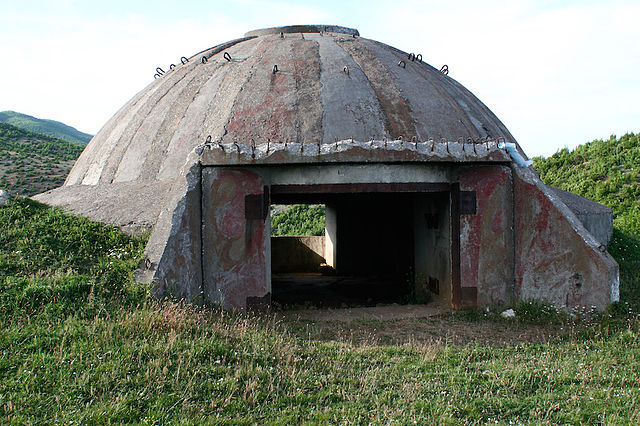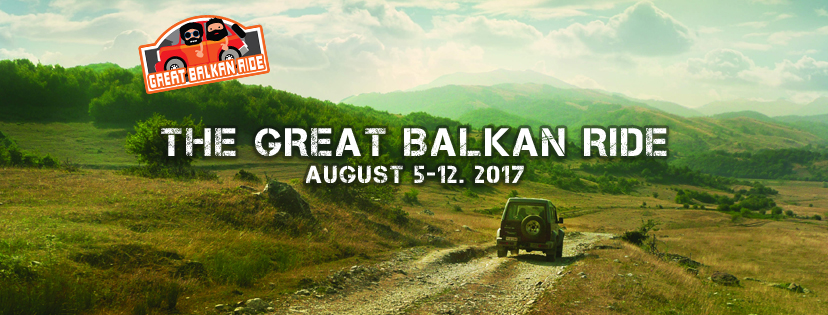Photo by Concrete Mushrooms Project
An introduction to Albania’s Concrete Bunkers.
Of all the countries explored by the Great Balkan Ride adventure rally, Albania is likely the most unknown and underrated. It has an incredibly diverse landscape, a unique culture, and a fascinating history. Albania’s concrete bunkers are the most visible relic of the country’s past, since they are to be seen everywhere. Really…. everywhere: on mountain tops, beaches, road sides. There are said to be 750,000 bunkers dotted around the country: that’s more than one per every four Albanians! Here’s what you need to know about Albania’s concrete bunkers.
What are Albania’s Concrete Bunkers For?

First, you need to know a little history. Between 1944 and 1985, Albania was ruled by Enver Hoxha, an authoritarian dictator. The country was communist and incredibly isolated: unlike Tito’s Yugoslavia, which tried to be friends with everyone, Hoxha saw both the “West” and the Soviet Union as enemies. He was paranoid about a potential invasion, and planned the bunkers as the first line of defence. If invasion were to occur, everyone would be required to fight, and the bunkers would protect them. The chief engineer claimed that each bunker, comprised of just concrete and steel, would be able to withstand an assault from a tank. Hoxha tested the design by firing from a tank at a prototype bunker… with the engineer inside. It passed the test, and mass production began in the late 1960s.
But the Invasion Never Came

There were several flaws in Hoxha’s plan. Firstly, there was no impending invasion. Secondly, the country could hardly afford the expense. Building the bunkers was a massive strain on Albania’s resources, with each one estimated to cost the same as a two-room apartment; at the same time, the country had a chronic shortage of housing. Perhaps even worse, many among Hoxha’s own military advisors considered the bunkers a less effective defence than a highly trained military. However, in-keeping with the dictator’s leadership style, any dissent was very quickly quelled. When Hoxha died in 1985, the bunkers stopped being built. But it’s no easy task to remove them…
So the Concrete Bunkers were Never Used?

Actually… the bunkers were used, briefly, in the 1990s. During the 1997 Albanian rebellion, the people of Sarandë apparently used the bunkers as defensive positions. The concrete bunkers also provided shelter for refugees from Kosovo. During NATO shelling of Kosovo, some bunkers in Albania were actually accidentally hit; and, hilariously, they crumbled. So the bunker scheme would’ve been a waste of money even if an invasion had arrived. Probably the biggest effect of the bunkers was to create the perfect metaphor for Albania’s siege mentality; the country’s isolationist paranoia itself became known as “bunkerization.”
What has become of them now?

Since the bunkers have proved so hard to remove, locals have come up with a variety of uses for them. In Durrës, visited by the Great Balkan Ride, one bunker has been transformed into a hip bar and hotel. Elsewhere you can find bunkers used as restaurants, cafes, nightclubs, or arts centers. More usually, you might see them used as a toilet, a changing room, or merely to provide some shade from the sun. One of Hoxha’s personal bunkers, a massive complex on the outskirts of Tirana, has been transformed into Bunk’Art, a museum and performance space. This is an essential place to visit if you’re nearby the capital, but if you’re anywhere else in the country you really don’t need to search them out… Albania’s concrete bunkers are everywhere!


[…] It almost seems unfair, but Albania, in addition to its enchanting mountains, is also home to some of the best beaches in Europe. The golden sands of the “Albanian Riviera” are unmissable, and if you pick the right spot you can avoid the crowds that you’d expect on more famous Mediterranean beaches. In some places your only company might be one of the remaining “concrete mushroom” bunkers. […]